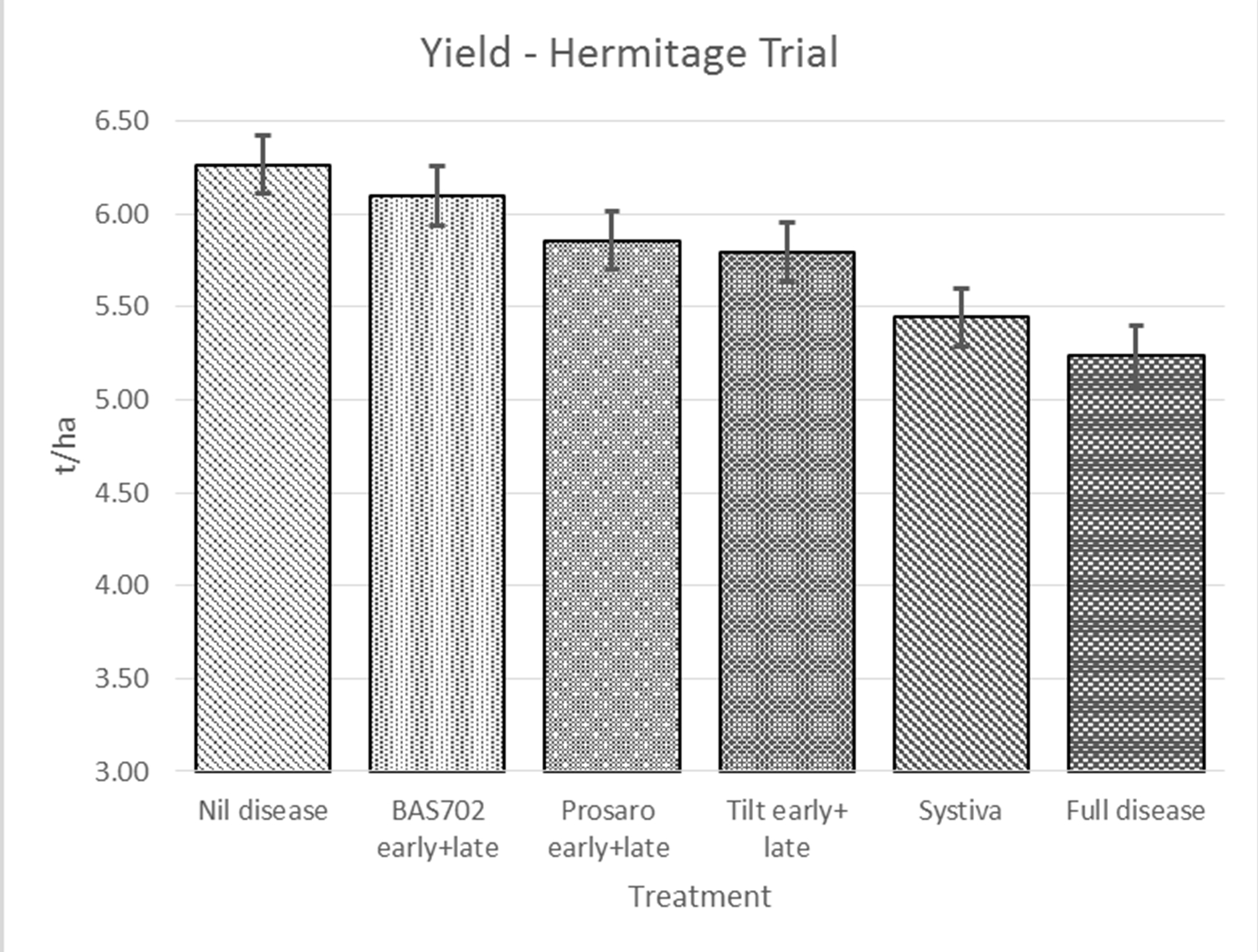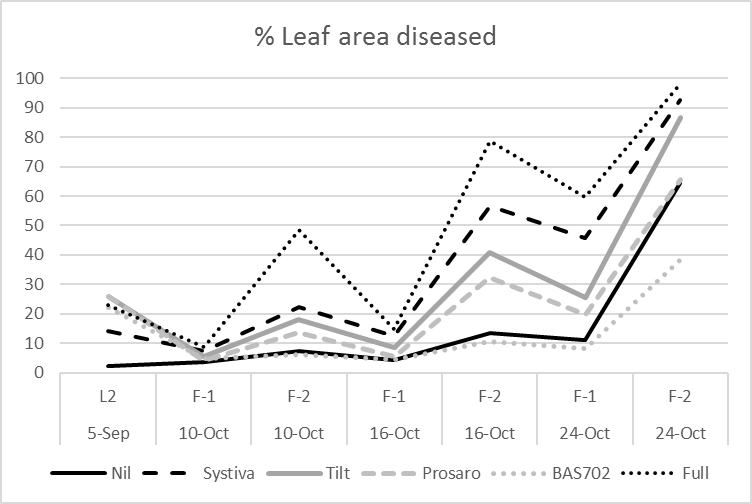Systiva performance in northern trials
Author: Greg Platz, Lisle Snyman, Ryan Fowler, Dept of Agriculture and Fisheries | Date: 28 Feb 2017
Take home messages
- Systiva® is a new seed treatment fungicide registered by BASF for the control of several foliar diseases of barley, smuts in barley, bunt in wheat and suppression of Rhizoctonia root rot in both.
- Systiva gives very good control of most foliar diseases for about 8 weeks of crop life.
- One or more supplementary sprays may be required for whole of season foliar disease control.
- Systiva is registered for loose smut control in barley but is ineffective against covered smut.
- Early season disease control slows disease epidemic development and increases yields where conditions after flag leaf emergence do not favour disease development.
- In 2017, seed treatment with Systiva is likely to cost approximately $15/ha or $30/100kg of seed.
- Systiva is a Group 7 fungicide and introduces new chemistry to seed treatment. Responsible use of the product is encouraged to prevent breakdown of efficacy.
Background
Systiva® gained APVMA approval for registration as a seed treatment fungicide in 2015. The active ingredient is fluxapyroxad - a Group 7 fungicide - and the first succinate dehydrogenase inhibitor (SDHI) registered for use on cereals in Australia. The product has had extensive trialling pre-release across Australia but there has been relatively limited product development in the heavier soils of the northern region.
Reports on the efficacy of Systiva from southern Australia have been very favourable with outstanding disease control in many situations. It is reported that across 80 trials Systiva gave a positive yield benefit of 350kg/ha (Pers. comm. R. Holzknect BASF).
Foliar diseases have a propensity for rapid epidemic development from low levels of inoculum, given suitable conditions for infection and spread, with the frequency and duration of leaf wetness a major driver of epidemic development. Differences in environmental conditions between southern Australia and the northern region during late crop development may influence the benefits of early season control.
Here we report the results of replicated trials conducted in 2014 and 2016 and a farm demonstration conducted in 2016 to determine the benefits of Systiva in the control of spot form net blotch. Further work needs to be done to determine the benefits of seed treatment with Systiva in controlling other diseases.
Trial results
Hermitage 2014
A replicated trial comparing the use of fluxapyroxad as either a seed treatment and/or spray was conducted at Hermitage in 2014. Systiva (fluxapyroxad) with and without a late foliar spray was compared to a popular commercial seed treatment and combinations of current commercial foliar fungicides for the control of spot form net blotch in Shepherd barley. Foliar applications were made at growth Stages 31 (early) and 41 (late) while nil disease treatments received 4 applications of Prosaro® at 300mL/ha. (Note that the Prosaro label limits use in commercial crops to a maximum of two applications per season.) There was a moderate to heavy epidemic of spot form net blotch present for the duration of the trial.
A summary of the yield results is shown in Figure 1.

Figure 1. Yields of Shepherd barley under different fungicide treatments to control spot form of net blotch.
Four applications of Prosaro did not give absolute disease control in the Nil disease treatments; yet still resulted in a significant yield increase of 19.6% over the full disease. The yield of the Systiva treatment alone resulted in a 4% increase in yield which was not significantly different from the full disease control. However, Systiva did give positive significant differences in test weight, retention, screenings and grain size over the full disease control treatment. In a malting variety the improvement in test weight and retention would have taken the classification from feed to malting quality.
Four assessments of leaf area diseased (LAD) were conducted between 5th September (8 weeks after sowing) and 24th October. At the first assessment it was obvious that Systiva (heavy dotted line) was having an effect on disease development (Fig. 2). The three Systiva treatments had an average of 13% LAD compared to the average of the foliar spray treatments (23.5%), which at that time had not had a spray applied. However, over subsequent assessments it was obvious that the foliar sprays were controlling the disease better than the Systiva treatment, which had %LAD levels increasing to nearer those of the full disease control (dark dotted line).

Figure 2. Percent leaf area diseased of six selected treatments.
It appeared that the effect of Systiva was waning as the crop was filling grain.
The leaves that contribute most to grain fill in barley in environments with sufficient soil moisture are the flag sheath, flag-1 and flag-2. Under conditions where epidemics of SFNB continue developing after heading, it appeared that Systiva applied without a follow-up treatment, was inferior to the application of foliar fungicides in controlling the disease and protecting grain yield.
GOA/ NSW DPI Trial 2016
Systiva was evaluated for spot form net blotch control in a replicated trial conducted by Steven Simpfendorfer (NSW DPI) and Maurie Street (GOA). Data was not available in time for inclusion in this paper but is presented in the paper by Simpfendorfer and Street in these proceedings.
Farmer Demonstration 2016
A broad-acre comparison of Systiva and Phoenix® (triadimenol) seed treatments for spot form net blotch control in Gairdner barley was conducted at Garah (Note: Phoenix not registered for spot form net blotch). The demonstration also incorporated stubble burnt vs unburnt. DAFQ personnel attended the field day in mid-July to compare disease control in the four treatments when the crop was at mid-tillering. Assessments were done on the last fully expanded leaf showing disease and the preceding leaf.
The lowest levels of disease were in the burnt treatment with little difference between seed treatments. The difference between the Systiva and Phoenix treatments in the stubble unburnt area was almost threefold, with Systiva having 11 and 14% LAD and Phoenix 32 and 40 % LAD (Figure 3).
It was visually obvious that the area treated with Systiva had much less disease than the Phoenix treatment.
The crop was harvested in October, but unfortunately yields were unavailable at the time of writing.

Figure 3. Percent leaf area diseased in Gairdner barley in response to seed and stubble treatments.
Conclusion
It appears that Systiva is quite effective in controlling spot form net blotch (and presumably other foliar diseases) for about 8 weeks after sowing based on results in these trials. Under conditions where disease epidemics continue to develop beyond this window, it is unlikely that Systiva will be persistent enough to provide adequate protection to the main yield contributing leaves of the flag sheath, flag-1 and flag-2. From observations and results from the limited trialling of the product in this region, it would be wise to budget at least one foliar spray in any disease management strategy using Systiva.
Acknowledgements
The authors thank Richard Holzknect (BASF), Dr Steve Simpfendorfer (NSW DPI), Maurie Street (GOA) and Rob Long (B&W Rural) for their input into this paper.
The research undertaken as part of this project is made possible by the significant contributions of growers through both trial cooperation and the support of the GRDC. The authors would like to thank them for their continued support.
Contact details
Greg Platz, Lisle Snyman & Ryan Fowler
Dept of Agriculture and Fisheries
604 Yangan Rd, Warwick QLD
Greg Platz
Ph: 0408 733 055
Email: Greg.Platz@daf.qld.gov.au
Lisle Snyman
Ph: 0428 324 932
Email: Lisle.Snyman@daf.qld.gov.au
Ryan Fowler
Ph: 0433 406 669
Email: Ryan.Fowler@daf.qld.gov.au
Varieties displaying this symbol are protected under the Plant Breeders Rights Act 1994.
® Registered Trademark
GRDC Project Code: DAQ00187,
Was this page helpful?
YOUR FEEDBACK
